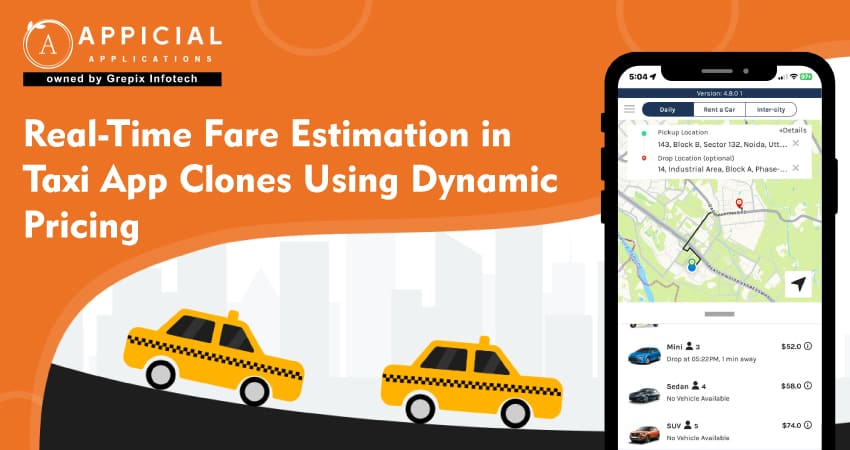
Real-Time Fare Estimation in Taxi App Clones Using Dynamic Pricing
Ever booked a cab thinking you’d pay a set amount, only to find yourself paying nearly double? We’ve all been there. That’s where real-time fare estimation steps in like a good friend who’s got your back.
In an instant-gratification, obsessed world food delivery in minutes, same day shipping, on-demand breaking news why must taxi fare calculation fall behind?
The fact is, static fare charts are antiquated. They don't take into account real-world scenario complexities such as rush hour traffic, unforeseen weather conditions, or random road closures. That's when a real-time fare calculator comes in. They adapt, update, and inform all in the blink of an eye.
With dynamic pricing taxi app integrations, you're not just guessing anymore. You're calculating, anticipating, and optimizing, both as a user and as a service provider.
Tired of haggling for a ride or being shocked by last-minute price hikes? You’re not alone. In today’s fast-paced world, people want everything in real-time, and yes, that includes knowing how much their taxi ride will cost. This blog dives deep into how real-time fare calculators and dynamic pricing taxi app logic are redefining modern ride-hailing experiences. We’ll walk through its importance, the user benefits, how businesses can implement it, and even share real-world examples. Finally, we’ll introduce you to Appicial Applications your go-to tech partner in launching smart, scalable taxi app clone pricing model solutions.
What Are the Benefits of Real-Time Fare Estimation for Users?
Real-time fare estimation isn’t just some trendy tech upgrade it’s reshaping the very expectations users have from modern ride-hailing services. It’s not about showing prices faster; it’s about building trust, improving experiences, and making smarter travel decisions. Here’s how it’s making a difference in everyday rides:
1 No More Nasty Surprises at the End of the Ride
You open a taxi app, input your destination, and everything seems straightforward, until the final bill hits you like a curveball. With a real-time fare calculator, that’s a thing of the past.
As soon as you enter your route, the app instantly pulls data on current traffic, driver availability, and other dynamic elements. The result? An accurate fare estimate upfront, before you ever tap "Book Now." No confusing surcharges. No unexplained hike mid-ride. Just clear pricing that puts the rider in control.
That level of transparency is empowering. People feel respected when they’re informed. And informed users are happy users.
2 Smarter Decisions, Better Day Planning
One of the unsung benefits of real-time fare calculators is how they support smarter travel choices. Imagine you’re deciding between a taxi and the metro. If your app shows a higher fare due to current peak hour demand, you might opt for public transit. On a lazy Sunday with light traffic? You might go with the cab for comfort.
This flexibility turns every ride into a personalized choice. No guessing. No assumptions. Just real-time facts to help you choose what makes the most sense for your schedule and your wallet.
For budget-conscious riders, this is a game-changer. And for service providers, it means more engaged users who are using the app proactively.
3 Pricing That Feels Fair and Clear
Let’s be honest: no one likes feeling ripped off. Traditional taxi pricing models often left users puzzled. Why did the same 3-mile trip cost $8 yesterday and $14 today?
Thanks to dynamic pricing taxi app algorithms, there's finally an answer. These systems consider everything from sudden demand spikes to route congestion to determine a real-time price. Yes, prices can surge, but users now understand why.
Because the pricing adapts to real-world conditions, it feels less arbitrary and more justified. That’s the power of real-time fare estimation; it adds logic where once there was guesswork.
When people see that their fare is based on transparent, visible data points, it breeds a sense of fairness. And fairness builds loyalty.
4 Boosted Trust in the Brand and the App
Transparency isn't just a feature, it’s a competitive edge.
Apps that offer accurate real-time fare calculators immediately appear more trustworthy than those that don’t. Why? Because they’re not hiding anything. They’re showing users exactly what to expect and why.
In a market full of taxi apps vying for attention, trust becomes the differentiator. Riders want to feel confident that they’re not being taken for a ride pun very much intended.
By incorporating dynamic pricing taxi app strategies that are visible and logical, brands show they respect their users. And respected users tend to stay loyal, recommend the service to others, and choose your app over competitors, even if fares occasionally run higher.
5Encouragement to Use the App More Often
Here’s something not everyone talks about: when users feel like they understand how pricing works, they actually use the app more. A smart, responsive taxi app clone pricing model gives users the impression that the app "gets" them it knows when to offer deals, when prices are high, and when it’s the best time to book.
That small touch of intelligence makes the entire experience feel customized. And let’s be real: in today’s world of hyper-personalization, that matters.
Behind the Code: How to Implement Real-Time Fare Estimation in Taxi App Clones
This isn’t magic. It's engineering with a touch of smart data science. So, if you’re planning to build or enhance a taxi app clone, here’s how you can do it right.
Step 1: Data & More Data
To build an accurate taxi app clone pricing model, you need real-time access to various datasets:
- Traffic conditions (via APIs like Google Maps or Waze)
- Fuel prices
- Distance between pickup and drop-off
- Estimated travel time
- Weather conditions
- Local events or roadblocks
- Driver availability
Your real-time fare calculator relies on these inputs to spit out a fare that's accurate to the second.
Step 2: The Algorithm That Talks Back
You’ll need an algorithm that isn’t just smart it’s responsive. It should:
- Use machine learning to recognize pricing patterns
- Calculate optimal routes and timings
- Update fare every few seconds during high volatility
- Cap prices to avoid over-surge (no one likes a $200 trip for 5 miles)
You don’t need to reinvent the wheel, but you do need to design one that rolls smoothly over real-world bumps.
Step 3: Surge Logic The Art of Dynamic Pricing
The heart of the dynamic pricing taxi app approach is surge pricing. But do it wrong, and you’ll alienate your users. Do it right, and you’ll optimize supply and demand.
Here's how to nail it:
- Set base fare ranges
- Add multipliers based on the demand-supply ratio
- Introduce caps or limits to avoid PR disasters
- Notify users in real-time when pricing changes
- Offer incentives like discounts during non-peak hours
This is not just a taxi app clone pricing model tweak. It’s a philosophy: charge more when demand is high, but don’t be greedy.
Step 4: Front-End Magic
Behind all that logic sits a user interface that needs to be clean, intuitive, and fast. Users don’t want to wait 5 seconds for a fare estimate to load. Speed matters.
Use caching, preload expected fares based on typical conditions, and keep the UI simple just show the price, the factors affecting it, and maybe a little note on why it costs what it costs.
Learning from the Real World: Case Studies of Real-Time Fare Estimation in Action
Nothing beats a good case study to see theory hit the streets. Here are a few:
1 Uber: The Surge King
Uber pioneered real-time surge pricing. Its algorithm monitors local demand, matches it with driver supply, and sets a multiplier accordingly. While this model sparked debates, it also showcased the power of dynamic pricing taxi app logic when executed at scale.
Takeaway? Users complained at first, but transparency and real-time fare displays helped Uber win long-term loyalty.
2 Lyft: User-Centric Transparency
Lyft went a step further with its upfront pricing display. Users see the final cost, including surge fees, right before they confirm the ride. No surprises.
That real-time clarity? It's a great example of what a well-designed real-time fare calculator can do for user satisfaction.
3 Ola: Smart Pricing for Diverse Markets
Ola operates in regions with wildly varying traffic and demand patterns. Its system tailors pricing based on city-specific conditions. Their taxi app clone pricing model includes weather sensitivity, festival triggers, and driver availability in remote zones.
They’ve built a model that adapts not just to the moment, but to the cultural and regional context.
Appicial Applications: Your Partner in Building Smarter Taxi App Clone Pricing Models
You might be wondering this all sounds great, but who’s going to build this for me?
Also Read: Gamification Strategies in Taxi App Clones to Boost User Engagement
That’s where Appicial Applications comes in. With a strong reputation in building scalable, intuitive taxi app clones, they’re the people you call when you want a real-time fare calculator that just works.
Why Choose Appicial?
- Deep expertise in dynamic pricing taxi app development
- Plug-and-play modules for quick deployment
- Customizable UI/UX tailored for your market
- Scalable backend with advanced fare estimation logic
- Proven taxi app clone pricing model frameworks that can be tweaked for your specific needs
They don’t just build apps they build systems that evolve with your business. Whether you’re targeting metropolitan chaos or rural calm, their tech fits.
And they’re not going anywhere. Ongoing support, updates, and market insights? They’re in it with you for the long haul.
Conclusion: The Future Rides on Real-Time
We live in an age where real time isn’t a luxury it’s the bare minimum. The modern rider expects instant information, personalized pricing, and no nonsense transparency. That’s what real-time fare estimation delivers.
With dynamic pricing taxi app strategies, you’re not just updating your tech you’re future-proofing your business.
With a real time fare calculator, you create trust. With a smart taxi app clone pricing model, you create revenue.
And with Appicial Applications, you get a partner who gets all of this someone who turns your taxi app vision into a living, breathing product that users love.
Let’s Ride This Innovation Wave
Thinking about launching your own ride-hailing app? Or upgrading your current one?
Reach out to Appicial Applications today. They’ll help you build a smarter, more responsive, and profit-driven taxi app that stands out in a crowded market. Real-time is the future. Make sure you’re riding with it.
Looking out to start your own venture like Uber ? Try out our HireMe Taxi Uber Clone, the easiest way to kick-start your taxi business.Author's Bio

Vinay Jain is the Founder at Grepix Infotech and brings over 12 years of entrepreneurial experience. His focus revolves around software & business development and customer satisfaction.
Back to blog list




